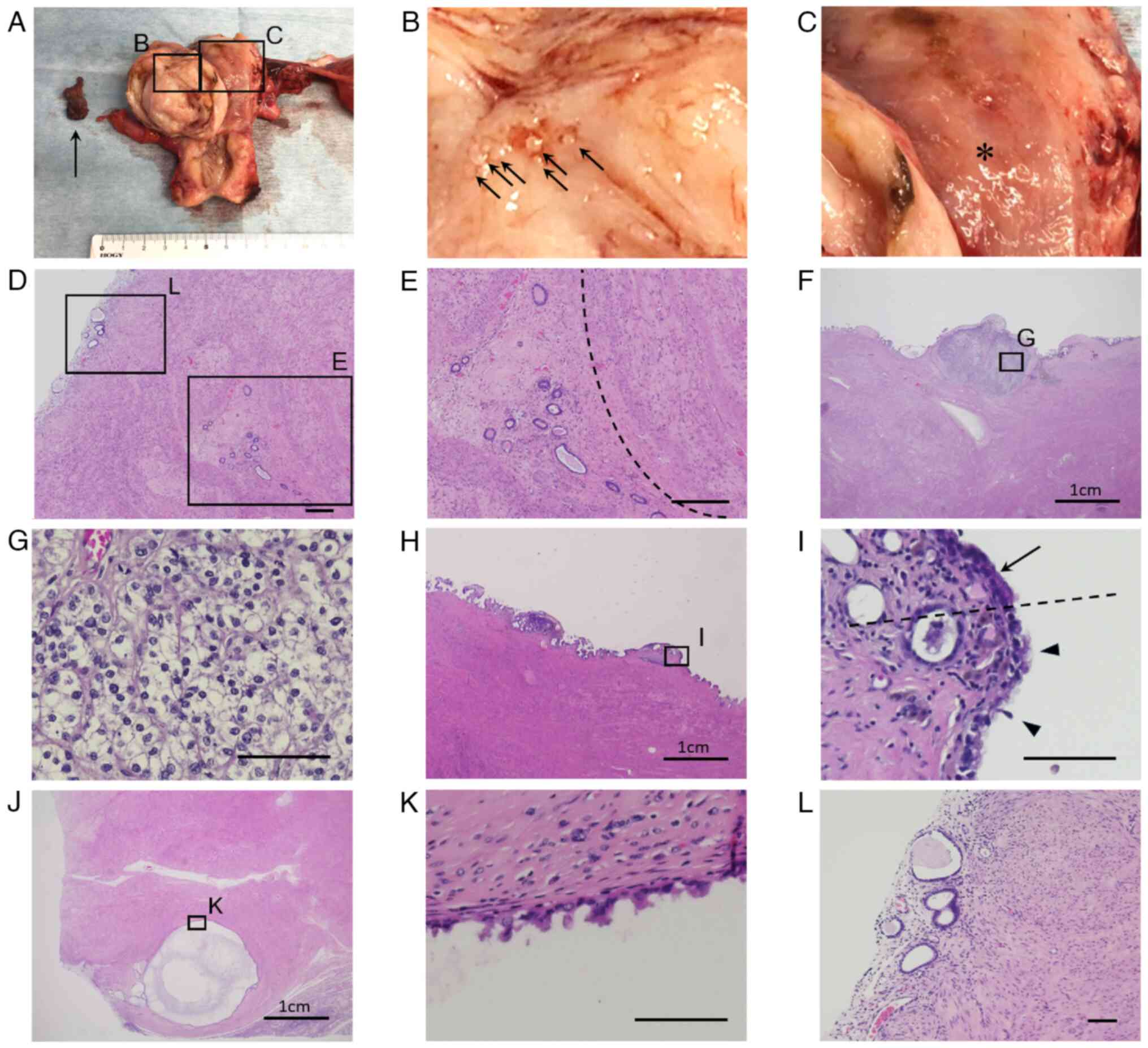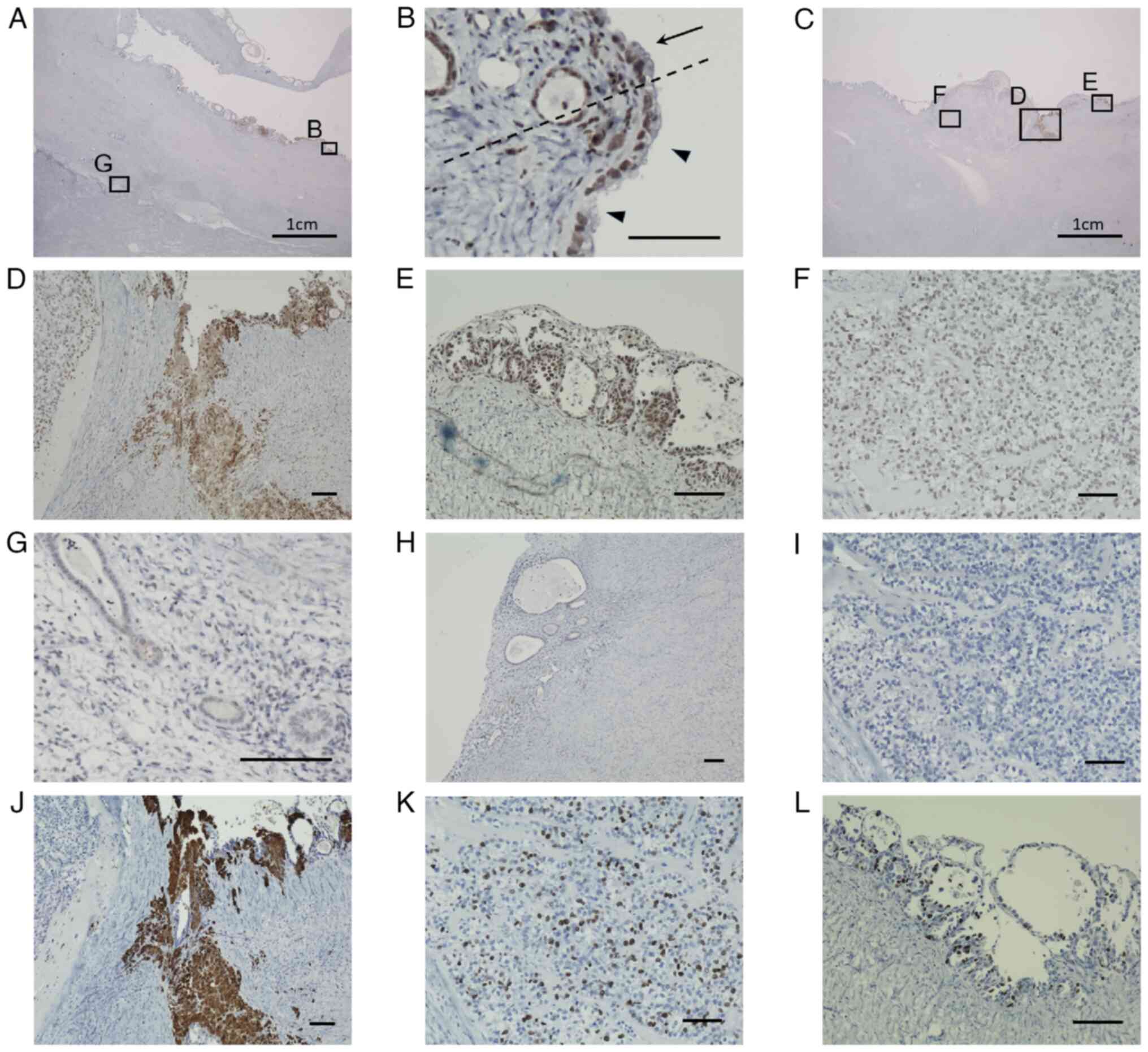|
1
|
Peric H and Fraser IS: The symptomatology
of adenomyosis. Best Pract Res Clin Obstet Gynaecol. 20:547–555.
2006.PubMed/NCBI View Article : Google Scholar
|
|
2
|
Machida H, Maeda M, Cahoon SS, Scannell
CA, Garcia-Sayre J, Roman LD and Matsuo K: Endometrial cancer
arising in adenomyosis versus endometrial cancer coexisting with
adenomyosis: Are these two different entities? Arch Gynecol Obstet.
295:1459–1468. 2017.PubMed/NCBI View Article : Google Scholar
|
|
3
|
Iizuka T, Ono M, Masumoto S, Mitani Y,
Yamazaki R and Fujiwara H: Amniotic epithelial cells damage by
oxidative stress in cases of diffuse chorioamniotic hemosiderosis.
J Obstet Gynaecol Res. 45:2095–2099. 2019.PubMed/NCBI View Article : Google Scholar
|
|
4
|
Sampson JA: Endometrial carcinoma of the
ovary, arising in endometrial tissue in that organ. Arch Surg.
10:1–72. 1925.
|
|
5
|
Colman HI and Rosenthal AH: Carcinoma
developing in areas of adenomyosis. Obstet Gynecol. 14:342–348.
1959.PubMed/NCBI
|
|
6
|
Mori M, Furusawa A, Kino N, Uno M, Ozaki Y
and Yasugi T: A rare case of endometrioid adenocarcinoma arising
from cystic adenomyosis. J Obstet Gynaecol Res. 41:324–328.
2015.PubMed/NCBI View Article : Google Scholar
|
|
7
|
Taniguchi F: New knowledge and insights
about the malignant transformation of endometriosis. J Obstet
Gynaecol Res. 43:1093–1100. 2017.PubMed/NCBI View Article : Google Scholar
|
|
8
|
Sampson JA: Metastatic or embolic
endometriosis, due to the menstrual dissemination of endometrial
tissue into venous circulation. Am J Pathol. 3:93–110. 43.
1927.PubMed/NCBI
|
|
9
|
Leyendecker G, Herbertz M, Kunz G and Mall
G: Endometriosis results from the dislocation of basal endometrium.
Hum Reprod. 17:2725–2736. 2002.PubMed/NCBI View Article : Google Scholar
|
|
10
|
Leyendecker G, Wildt L and Mall G: The
pathophysiology of endometriosis and adenomyosis: Tissue injury and
repair. Arch Gynecol Obstet. 280:529–538. 2009.PubMed/NCBI View Article : Google Scholar
|
|
11
|
Yamaguchi K, Mandai M, Toyokuni S,
Hamanishi J, Higuchi T, Takakura K and Fujii S: Contents of
endometriotic cysts, especially the high concentration of free
iron, are a possible cause of carcinogenesis in the cysts through
the iron-induced persistent oxidative stress. Clin Cancer Res.
14:32–40. 2008.PubMed/NCBI View Article : Google Scholar
|
|
12
|
Mandai M, Matsumura N, Baba T, Yamaguchi
K, Hamanishi J and Konishi I: Ovarian clear cell carcinoma as a
stress-responsive cancer: Influence of the microenvironment on the
carcinogenesis and cancer phenotype. Cancer Lett. 310:129–133.
2011.PubMed/NCBI View Article : Google Scholar
|
|
13
|
Wiegand KC, Shah SP, Al-Agha OM, Zhao Y,
Tse K, Zeng T, Senz J, McConechy MK, Anglesio MS, Kalloger SE, et
al: ARID1A mutations in endometriosis-associated ovarian
carcinomas. N Engl J Med. 363:1532–1543. 2010.PubMed/NCBI View Article : Google Scholar
|
|
14
|
Xu TX, Zhao SZ, Dong M and Yu XR: Hypoxia
responsive miR-210 promotes cell survival and autophagy of
endometriotic cells in hypoxia. Eur Rev Med Pharmacol Sci.
20:399–406. 2016.PubMed/NCBI
|
|
15
|
Niiro E, Kawahara N, Yamada Y, Yoshimoto
C, Shimada K, Sudo T and Kobayashi H: Immunohistochemical
expression of CD44v9 and 8-OHdG in ovarian endometrioma and the
benign endometriotic lesions adjacent to clear cell carcinoma. J
Obstet Gynaecol Res. 45:2260–2266. 2019.PubMed/NCBI View Article : Google Scholar
|
|
16
|
Tsuchimochi S, Wada-Hiraike O, Urano Y,
Kukita A, Yamaguchi K, Honjo H, Taguchi A, Tanikawa M, Sone K,
Mori-Uchino M, et al: Characterization of a fluorescence imaging
probe that exploits metabolic dependency of ovarian clear cell
carcinoma. Sci Rep. 13(20292)2023.PubMed/NCBI View Article : Google Scholar
|
|
17
|
Marí-Alexandre J, Carcelén AP, Agababyan
C, Moreno-Manuel A, García-Oms J, Calabuig-Fariñas S and
Gilabert-Estellés J: Interplay between MicroRNAs and oxidative
stress in ovarian conditions with a focus on ovarian cancer and
endometriosis. Int J Mol Sci. 20(5322)2019.PubMed/NCBI View Article : Google Scholar
|
|
18
|
Hsu JY, Reimann JD, Sørensen CS, Lukas J
and Jackson PK: E2F-dependent accumulation of hEmi1 regulates S
phase entry by inhibiting APC(Cdh1). Nat Cell Biol. 4:358–366.
2002.PubMed/NCBI View
Article : Google Scholar
|
|
19
|
Gütgemann I, Lehman NL, Jackson PK and
Longacre TA: Emi1 protein accumulation implicates misregulation of
the anaphase promoting complex/cyclosome pathway in ovarian clear
cell carcinoma. Mod Pathol. 21:445–454. 2008.PubMed/NCBI View Article : Google Scholar
|
|
20
|
Wang C, Liang Z, Liu X, Zhang Q and Li S:
The association between endometriosis, tubal ligation, hysterectomy
and epithelial ovarian cancer: Meta-Analyses. Int J Environ Res
Public Health. 13(1138)2016.PubMed/NCBI View Article : Google Scholar
|
|
21
|
Mori Y, Inoue Y, Sakai K, Koizumi M,
Okamura N, Sato K and Mizuuchi H: Primary clear cell carcinoma
arising in cystic adenomyosis of the uterus-a case report. Nihon
Sanka Fujinka Gakkai Zasshi. 46:915–917. 1994.PubMed/NCBI(In Japanese).
|
|
22
|
Shinozaki H, MR Ishizuka Y, Sugiura K,
Nishii H, Watanabe A, Ochiai K and Tanaka T: A case of malignant
transformation of cystic adenomyosis in which fine-needle
aspiration cytology led to the diagnosis. Nihon Rinsho Saibo Gakkai
Zasshi. 39(370)2000.(In Japanese).
|
|
23
|
Tsunota C, MK Motoyama T, Yasuda J and
Tatebe A: A case of uterine corpus cancer thought to have arisen
from cystic adenomyosis. Shojinkai Igaku Zasshi. 43:151–155.
2004.(In Japanese).
|
|
24
|
Ohta Y, Hamatani S, Suzuki T, Ikeda K,
Kiyokawa K, Shiokawa A, Kushima M and Ota H: Clear cell
adenocarcinoma arising from a giant cystic adenomyosis: A case
report with immunohistochemical analysis of laminin-5 gamma2 chain
and p53 overexpression. Pathol Res Pract. 204:677–682.
2008.PubMed/NCBI View Article : Google Scholar
|
|
25
|
Heo SH, Lee KH, Kim JW and Jeong YY:
Unusual manifestation of endometrioid adenocarcinoma arising from
subserosal cystic adenomyosis of the uterus: Emphasis on MRI and
positron emission tomography CT findings. Br J Radiol.
84:e210–e212. 2011.PubMed/NCBI View Article : Google Scholar
|
|
26
|
Okuyama D, OM Kotani M and Suzuki A: A
case of clear cell adenocarcinoma of the uterine corpus suspected
to have developed from cystic adenomyosis. Tokyo J Ob-Gyn.
62:131–137. 2013.(In Japanese).
|
|
27
|
Ito M, SK Owada M, Suzuki H and Saito A: A
case of clear cell adenocarcinoma suspected to have developed from
cystic adenomyosis. Fukushima Journal of Medical Science. 64:29–33.
2014.(In Japanese).
|
|
28
|
Ohta Y, MK Yonezawa M and Mizuno K: A case
of uterine corpus cancer arising from cystic adenomyosis. Kanto J
Obst Gynec. 53:553–559. 2016.(In Japanese).
|
|
29
|
Baba A, Yamazoe S, Dogru M, Ogawa M,
Takamatsu K and Miyauchi J: Clear cell adenocarcinoma arising from
adenomyotic cyst: A case report and literature review. J Obstet
Gynaecol Res. 42:217–223. 2016.PubMed/NCBI View Article : Google Scholar
|
|
30
|
Ueda M, KJ Okabe M, Morikawa K, Miyahara
Y, Katayama Y, Matsuoka T, Sekino K, Masumoto K and Komatsu R: Two
cases of uterine corpus cancer thought to have arisen from
adenomyosis. Gendai Sanfujinka. 64:303–308. 2016.(In Japanese).
|
|
31
|
Amimoto S, UT Tohyama A, Atsui C, Kurita
T, Kagami S, Kawagoe T, Matsuura Y and Hachisuka T: A case of
uterine corpus cancer thought to have arisen from adenomyosis. Acta
Obstetrica et Gynaecologica Japonica. 70(760)2020.(In
Japanese).
|
|
32
|
Sakata K, YT Jingi A, Kawamura T, Hirata T
and Kihira T: A case of clear cell adenocarcinoma suspected to have
developed from cystic adenomyosis. The Tokai Journal of Obstetrics
and Gynecology. 53:205–211. 2017.(In Japanese).
|
|
33
|
Okamoto S, HN Mizusaki M, Hamada K, Kita
K, Ichikawa H, Takahashi T, Kato I, Katayama H and Sengoku K: A
case of clear cell adenocarcinoma suspected to have developed from
cystic adenomyosis. Journal of the Hokkaido Obstetrical and
Gynecological Society. 64(106)2020.(In Japanese).
|
|
34
|
Gomez NF, Still MA, Akki AS,
Carbajal-Mamani SL and Cardenas-Goicoechea J: Uterine clear cell
carcinoma arising from cystic adenomyosis: A case report. J Obstet
Gynaecol Res. 41:1175–1177. 2021.PubMed/NCBI View Article : Google Scholar
|
|
35
|
Dateki M, OA Yamaguchi T, Ueno N, Fujisaki
A, Kawagoe Y and Samejima H: A case of endometrial cancer arising
from cystic adenomyosis. Acta Obstetrica et Gynaecologica Japonica.
73(396)2021.(In Japanese).
|












